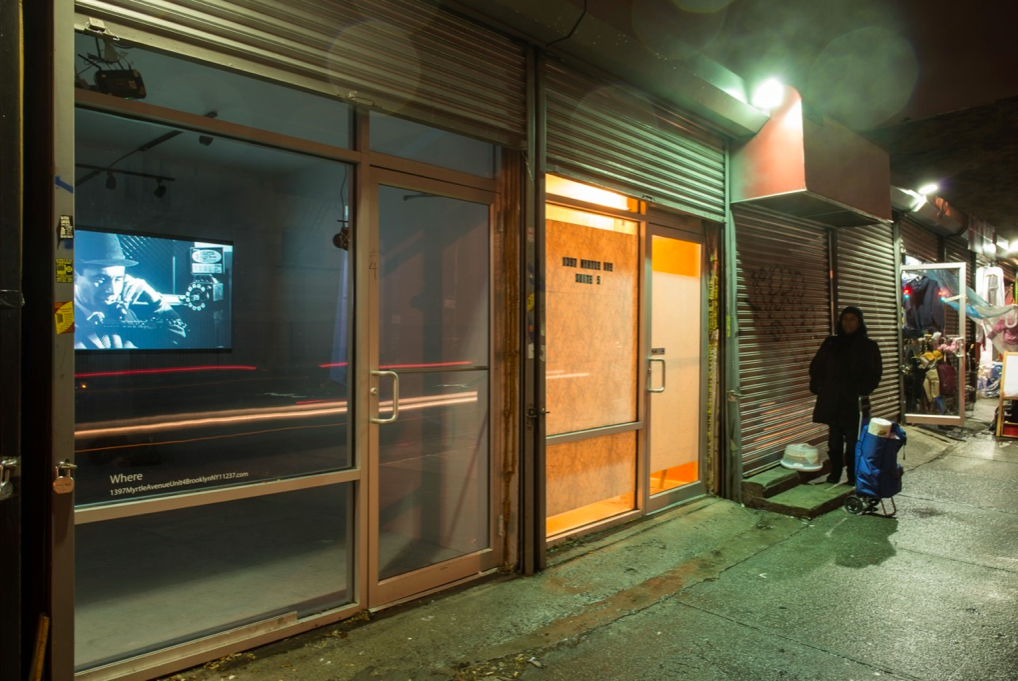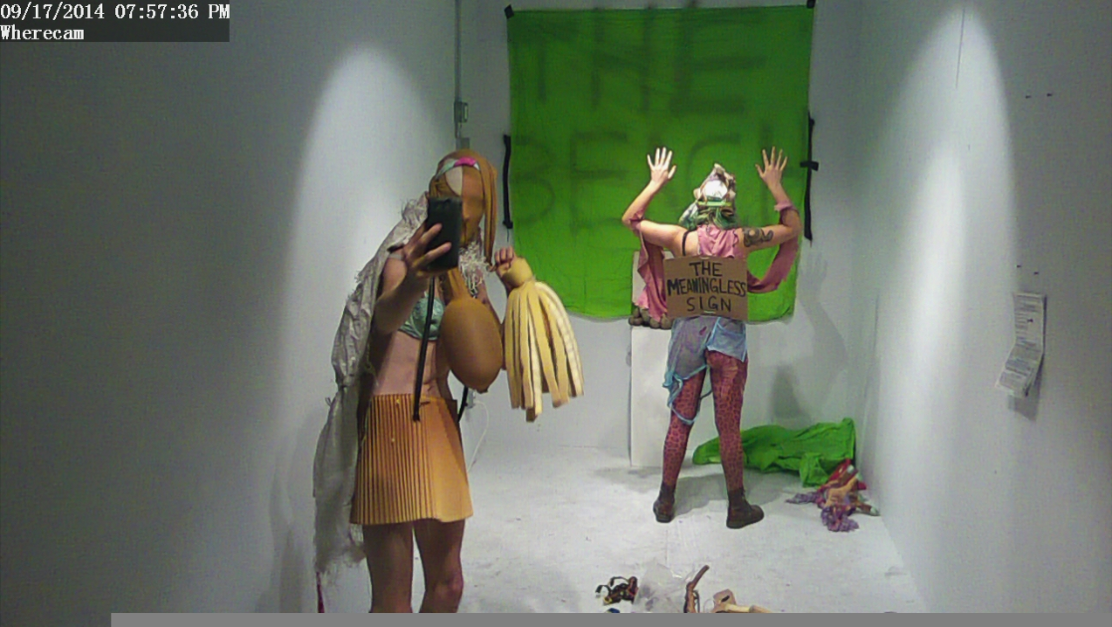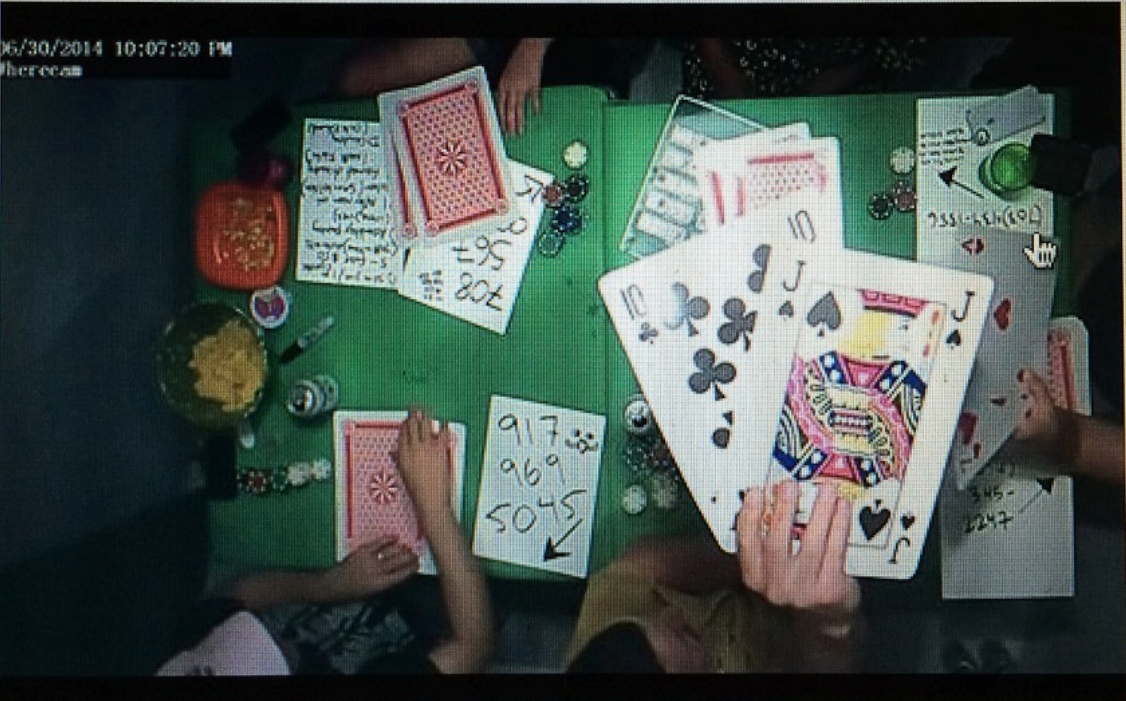Freight and Message: Views on Distribution and Standardization from a Shipping Container in Brooklyn
 Saturday, November 14, 2015 at 9:48PM
Saturday, November 14, 2015 at 9:48PM Lucy Hunter and R. Lyon
[ PDF Version ]
One sees shipping containers while in transit, looking down from a plane window or passing laterally on the freeway: miles upon miles of orange, blue, and green corrugated steel boxes, stacked five high and six deep at shipyards and train depots.
This familiar encounter inverts the containers’ operational logic and our place within it. The vast mobility of these containers dwarf the relative immobility of people. Movement is their unifying ethic. Seventeen million and counting, they haul bananas, microchips, bolts of fabric, flat-screen TVs—any material, at any stage of the supply chain—in regulation 20- or 40-foot boxes. The system for trafficking containers is called “intermodal freight”: standardized trucks, ships, and trains all specially fitted for the frictionless handoff of containers ad infinitum. These boxes parse the global into the local: their contents land at a corner grocery store, a mechanic shop, a cane-juice processing plant. Containers ping across the globe, and we receive them.
It’s a mode of passive consumption readily associated with digital media, that which transformed “searching” into a desk-chair pursuit. There is a particular resemblance between the distribution of digital information across fiber optic networks and the distribution of material goods across global freight routes. An inextricable, if inconspicuous, codependence links these two dominant systems of contemporary distribution. It is an ethos of standardization which aims to maximize efficiency, or minimize travel time, by compressing the thing in transit into modular units.
Our work at Where issues from the juncture of these two systems. Where is an exhibition space and publishing platform headquartered in a shipping container, co-directed by the authors of this essay. Where produces investigations into the principles that ground these distribution systems; we explore them through collaborations with artists as both methodological framework and object of study. In the following essay we will sketch out some of the parallel ontologies of shipping containers and bits, and identify contemporary art and its discourse as an ideal testing ground for this type of inquiry.
***
Containerization is among the great standardizations of modernity, on par with the regulation of rail widths, the sprocket-gap of celluloid film, and the synchronization of clocks by time zone.
Intermodal freight came into existence in 1956 with Malcom McLean’s customized Ideal-X ocean liner hauling fifty 35-foot shipping containers, ready to unload at their destination port onto McLean’s specialty truck beds. McLean did not invent shipping containers, but he is the protagonist in what’s now referred to as the history of “containerization.”[1] His fundamental insight had less to do with a mastery of engineering or hardware than with a single-minded focus on distributive architecture. His was a vision that saw trucking, shipping, and rail freight not as distinct activities of steering boats, trucks, and trains, but rather as various means of achieving the same end, that is, moving “freight.” Freight, to McLean, was a kind of idealized, undifferentiated modeling unit, erased of any identifying characteristics such as size, shape, or destination: the economists’ “widget” brought to life. In order for McLean to increase speed and reliability of transit, all while reducing cost, he had to normalize freight.
***
Ten years before McLean’s Ideal-X, its parallel informatic unit was born. In 1948, Claude Shannon, a 32-year-old engineer and cryptographer at Bell Labs, published his declassified essay “A Mathematical Theory of Communications” across two issues of the Bell System Technical Journal. This essay would immortalize Shannon as the founding figure of the information age.[2] His innovation was theoretical, an elaboration of an idea so embedded in collective consciousness that it now seems obvious: any message between a sender and receiver can be quantized and measured in terms of its information content. Whether a telegraph message across copper wires, a chemical trigger in the bloodstream, or a birdcall in a bustling forest, all messages are the same in that they are all designed to carry information from point A to point B. A message is transmissible if its ratio of signal to noise, or message to interference, is adequately low. To better model this ratio, Shannon created a unit for discrete quantities of information: the binary digit, or bit.
***
To discuss shipping containers and bits as units of measurement is necessary but not sufficient to describe the cross-wired logic of digital distribution and global freight. Quantization functions in the service of time; it is a handmaiden to precision and regulation. Two years prior to the publication of his landmark text on communications, Shannon circulated a classified memo on September 1, 1946, titled “A Mathematical Theory of Cryptography,” published in 1949 as “Communication Theory of Secrecy Systems.”[3] “Secrecy systems” refer to any message designed to resist interception while traveling between sender and receiver. Encryption strategy at that time was simply to build the strongest, most impenetrable secrecy system for use at all times. Shannon disagreed, and offered a radically new definition—one based not on security, but on timing. A message need only be secret as long as its information is sensitive. For instance, if a radiogram reads “Attack at noon,” the cipher must only elude the enemy until noon has passed; thereafter, the message is worthless, self-evident in enemy hands. Shannon’s insight was to model encryption as a function of the time required to dismantle it; the game was one of calculated delay.
Written just as the war was winding down, “Communication Theory of Secrecy Systems” sees its concepts realized not only in military strategy, but also in industrial production. Just in Time (JIT) manufacturing is a production method that eliminates excess inventory through precise deliveries of factory materials.[4] At an ideal JIT auto manufacturing plant, the tires from the tire factory arrive to the auto plant just as they are needed to be placed on the wheels. Under the JIT system, any excess inventory, warehousing, or storage is a waste of resources. If secrecy systems hinged on predicting delay, JIT hinges on predicting arrival. Both demand narrow margins of success—too simple a cipher, or too lean an order of exhaust pipes, spells catastrophe.
It doesn’t matter where parts are put together; it matters when. And the “when” must be precisely timed and controlled by machines operating on scales that exceed human capacity or imagination: thousand-ton cranes hauling containers, lightning-fast servers sending bits. In the era before mechanized computers the time-delta for decryption, or inventory, or delivery time, referred to human labor: slide rules and pencils, longshoreman and teamsters.[5] As mechanization pervaded every aspect of the supply and distribution chain—encouraged both by computing technology on one side and shipping technology on the other—this time-axis would correlate to a machine’s calculating speed, initiating a microchip arms race for brute calculating force that continues to this day. JIT requires a constant information stream from every point of the system. Precise inventory assessments are required to keep the machinery running lean and smooth; from the beginning, this kind of managerial control was made possible by computers, running constant algorithms on punch cards coded with inventory. JIT today is a total cybernetic feedback loop that accounts for production delays, traffic, anticipatory purchasing, energy price fluctuations, and nearly every dynamic process that can impact manufacture, distribution, and sales. The total immersion of distributive systems becomes advanced by “asset tracking”: cranes which use Optical Code Recognition (OCR) software to “read” the identification number of each unique shipping container, and radio frequency identification (RFID) and GPS tags implanted into cranes and port machinery. Tracking strives for omniscient knowledge of the moving parts in a distribution chain, inputs for a computer’s complex algorithms to endlessly model and adjust to a constantly moving field.
The rise of automated production and JIT completes a full circle that began its course in 1956. As McLean saw the unity of rail, truck, and shipping as one system populated by the unitary shipping container, JIT applied the precise standardization and tracking of containers to the entire manufacturing, distribution, and assembly chain. These procedures constitute one massive mechanism of production, an informational systems architecture wedded to a physical distribution network that cannot be discussed independently of each other. It’s a trajectory still in full force—Amazon’s automated warehousing unloads and distributes the contents of shipping containers in vast lightless rooms navigated by semi-intelligent machines. The fallacy of the information economy is that it’s somehow divorced from the means of production. Shipping standardization, JIT, and modern warehousing protocols are evidence of what capital identified fifty years ago. Virtual informational models and methods of physical manufacture and distribution are co-extensive, deeply symbiotic.
***
At Where we identified that these confrontations between a physical object and its network of delivery, between a thing and the information which surrounds it, can be teased out with contemporary artworks and their discourse. Much like conversations about the “information economy,” discourse on contemporary art is too often described in terms of its symptoms—ephemerality, screens, “virtuality.” Discussions on the dematerialization of art and digital media tend to fetishize the ephemeral and immaterial qualities of moving data over their source. What’s lost in this description is the material expenditures of these dazzling screen images: vast mining operations digging for the trace metals at the heart of the microchip, windowless server farms that are measured in acres, the neoliberal “indentured-lite” conditions of workers at all steps of the supply chain, and of course the black smoke of fossil fuels required to sustain the entire network of production. These are important and often overlooked corollaries, material and ideological, between our usual dialogue on networks and informational architecture, and the historical concomitance of digital media, standardization, and containerization.
When introducing Where in conversation, we are often asked if it is spelled W-A-R-E or W-H-E-R-E. The storage/inventory homonym is usually offered first, as if the more likely of the two. We prefer the latter because it offers a question in lieu of an address. Effectively, however, it is both: ware and where, freight and message. At Where we try to revive classical systems theory to mine its specific vocabulary developed to discuss movement, timing, mechanization, modeling, standardization, control systems, and the permeability of information across forms; these are the operative forces of global distribution and of art, and they apply as readily to digital media as to material goods.
Where 2, our second exhibition in collaboration with curator A. E. Benenson, is an apposite example. Subtitled “an investigation into recursion,” it operated on simultaneous and circular but differentiated channels of information. The exhibition staged a bootleg version of Douglas Gordon’s classic durational video 24 Hour Psycho; in this artwork from 1993, Gordon reduced the frame rate of Hitchcock’s classic and projected his protracted appropriation.
Where’s bootleg copy did not resolve itself so easily. Benenson, ostensibly the curator of the show, selected Gordon’ s piece as the work for exhibition but instead projected an illegally downloaded version of Psycho every evening inside the container. Glowing soundless in our storefront, the projection lit up the dark February sidewalk for an unsuspecting audience of passersby. When the credits began to roll, the projector would quietly turn itself off until the following day. This apparatus was further complicated by our streaming webcam which “buffered” the video, like a broken Netflix movie and—through a controlled staccato slideshow—released the doubly bootlegged Hitchcock video at two frames per second, requiring, of course, 24 hours to complete. The sum total: a bootlegged circuit from Hitchcock to Douglas to Where.
We liked how Benenson’s project refused to resolve itself around a single mode of exhibition. One could see Hitchcock in person at the gallery, or see Gordon on our web site, but the “location” of the work—and of the curators staging it—remained elusive. Physical and informational distribution were co-dependent but incoherent.
Where 2 is an analogy for the structure of Where and our place as actors within it: the shipping container and the work it houses is just an anchor for a larger project of looking at the exhibition format as part of a network of informational strategies. Our name then becomes a nod to an ambiguous position in the distribution systems of art: un-glamorously tucked under the M train in Brooklyn, miles from Chelsea galleries, our activities inside our corrugated black box are far more easily accessed through the 24-7 streaming webcam that is a central part of our infrastructure. We contend that the notion of the “virtual” is not so much about the non-physical as it is about discrete, standardized, and precisely timed forms of distribution.

For Where 2, Where collaborated with curator A. E. Benenson on a recursive appropriation of Douglas Gordon’s durational video 24 Hour Pyscho. Hitchcock’s Psycho screened once daily in the gallery, and the footage streamed via webcam to the gallery’s website at Gordon’s prescribed speed of 2 frames per second to create a continuous, unauthorized digital version of 24 Hour Psycho.

Where 4 was a three-month unfolding investigation into the generative possibilities of “constraint.” Artist Brock Enright held one-on-one “instructional encounters” with willing volunteers inside the container.

Where 5 involved an open invitation, distributed in online announcements and flyers: the lockbox code and address of the gallery, which was open to anyone, for anything, for one month.

Webcam still from Where 5.

“Eye in the Sky Hold’em”: Artist Melissa Brown transformed Where into a poker lounge, with the webcam acting as an “eye in the sky,” a portal for spies and accomplices, as players wagered their artwork among other forms of currency. The games were broadcast live, as were the players’ phone numbers, encouraging the help from remote, anonymous accomplices.
Notes
[1] The definitive resource for shipping container history is The Box by Mark Levinson. This comprehensive history includes not only McLean’s contributions, but military R&D and competing corporations that led to the rise of global freight. Mark Levinson, The Box: How The Shipping Container Made the World Smaller and the World Economy Bigger (Princeton, NJ: Princeton University Press, 2006).
[2] Claude E. Shannon, “A Mathematical Theory of Communication,'' Bell System Technical Journal 27, no. 3 and no. 4 (July and Oct. 1948): 379–423 and 623–56.
[3] Claude E. Shannon, “Communication Theory of Secrecy Systems,” Bell System Technical Journal 28, no. 4 (October 1949): 656–715.
[4] JIT was popularized by Toyota in the mid-70s; for a coherent explanation of the rise of “lean manufacture” in automobile manufacture, and a comparison between it and earlier, Fordist “mass production” strategies, see: James P. Womack, Daniel T. Jones, and Daniel Roos, The Machine That Changed the World, 2nd ed. (New York: Free Press, 2007).
[5] While not the focus of this paper, containerization instantiated a massive labor displacement of dockworkers and ship crews by automated loading cranes. Levinson details this, and the dismantling of labor unions, entailed by the shift to mechanization. Levinson, The Box.
Lucy Hunter is a writer and curator based in Brooklyn, NY. She is a Ph.D. student in the History of Art at Yale University, where she researches historical intersections of data, images, and machines in the late-19th through mid-20th centuries. Her work has appeared in the Brooklyn Rail, Interventions, and Periscope. She co-directs Where, a shipping container and publishing platform in Brooklyn.
lucy-hunter.com
R. Lyon received an MFA from Columbia University in 2012, where he was awarded the Jacob K. Javits Scholarship. His performance and installation-based works question the conditions of viewing and subjectivity in the digital age. Lyon’s works have been exhibited internationally at the Goethe-Institut, Mountain Fold, and Kunsthall Hasselt in Belgium, and he has performed at such venues as the CTM in Berlin, Performa 13 in New York, Netmage in Italy, and ISEA 2011. He co-directs Where, a shipping container, publishing platform, and think tank in Brooklyn.
irlyon.com
Where is a semi-public, high-security security shipping container and publishing project in Brooklyn, New York. It is grounded in the assertion that art manifests the same patterns, behaviors, and properties present in all complex informational systems. We believe that the mechanisms identified as producing growth and complexity in these systems are directly applicable to the field of artistic production. Where uses the exhibition format as a site for researching these operations.
1397myrtleavenueunit4brooklynny11237.com
Reader Comments